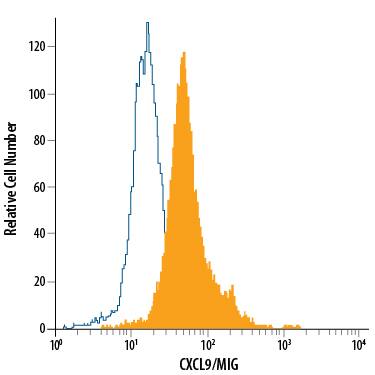Human CXCL9/MIG Fluorescein-conjugated Antibody
R&D Systems, part of Bio-Techne | Catalog # IC392F


Key Product Details
Validated by
Species Reactivity
Validated:
Cited:
Applications
Validated:
Cited:
Label
Antibody Source
Product Specifications
Immunogen
Thr23-Thr125
Accession # Q07325
Specificity
Clonality
Host
Isotype
Scientific Data Images for Human CXCL9/MIG Fluorescein-conjugated Antibody
Detection of CXCL9/MIG in THP‑1 Human Cell Line by Flow Cytometry.
THP-1 human acute monocytic leukemia cell line treated with Recombinant Human IFN-gamma (Catalog # 285-IF) in the presence of Monensin for 24 hours was stained with Mouse Anti-Human CXCL9/MIG Fluorescein-conjugated Monoclonal Antibody (Catalog # IC392F, filled histogram) or isotype control antibody (Catalog # IC002F, open histogram). To facilitate intracellular staining, cells were fixed with Flow Cytometry Fixation Buffer (Catalog # FC004) and permeabilized with Flow Cytometry Permeabilization/Wash Buffer I (Catalog # FC005). View our protocol for Staining Intracellular Molecules.Applications for Human CXCL9/MIG Fluorescein-conjugated Antibody
Intracellular Staining by Flow Cytometry
Sample: THP‑1 human acute monocytic leukemia cell line treated with Recombinant Human IFN‑ gamma (Catalog # 285-IF) in the presence of Monensin was fixed with Flow Cytometry Fixation Buffer (Catalog # FC004) and permeabilized with Flow Cytometry Permeabilization/Wash Buffer I (Catalog # FC005)
Formulation, Preparation, and Storage
Purification
Formulation
Shipping
Stability & Storage
- 12 months from date of receipt, 2 to 8 °C as supplied.
Background: CXCL9/MIG
CXCL9, a member of the alpha subfamily of chemokines that lack the ELR domain, was initially identified as a lymphokine-activated gene in mouse macrophages. Human CXCL9 was subsequently cloned using mouse MIG cDNA as a probe. The CXCL9 gene is induced in macrophages and in primary glial cells of the central nervous system specifically in response to IFN-gamma. CXCL9 has been shown to be a chemoattractant for activated T-lymphocytes and TIL but not for neutrophils or monocytes. The human CXCL9 cDNA encodes a 125 amino acid (aa) residue precursor protein with a 22 aa residue signal peptide that is cleaved to yield a 103 aa residue mature protein. CXCL9 has an extended carboxy-terminus containing greater than 50% basic aa residues and is larger than most other chemokines. The carboxy-terminal residues of CXCL9 are prone to proteolytic cleavage resulting in size heterogeneity of natural and recombinant CXCL9. CXCL9 with large carboxy-terminal deletions have been shown to have diminished activity in the calcium flux assay. A chemokine receptor (CXCR3) specific for CXCL9 and IP-10 has been cloned and shown to be highly expressed in IL-2-activated T-lymphocytes. The E. coli-expressed CXCL9 preparations produced at R&D Systems have been shown to contain greater than 80% full length CXCL9.
References
- Loetscher, M. et al. (1996) J. Exp. Med. 184:963.
- Liao, F. et al. (1995) J. Exp. Med. 182:1301.
- Vanguri, P. (1995) J. Neuroimmunol. 56:35.
Alternate Names
Gene Symbol
UniProt
Additional CXCL9/MIG Products
Product Documents for Human CXCL9/MIG Fluorescein-conjugated Antibody
Product Specific Notices for Human CXCL9/MIG Fluorescein-conjugated Antibody
For research use only